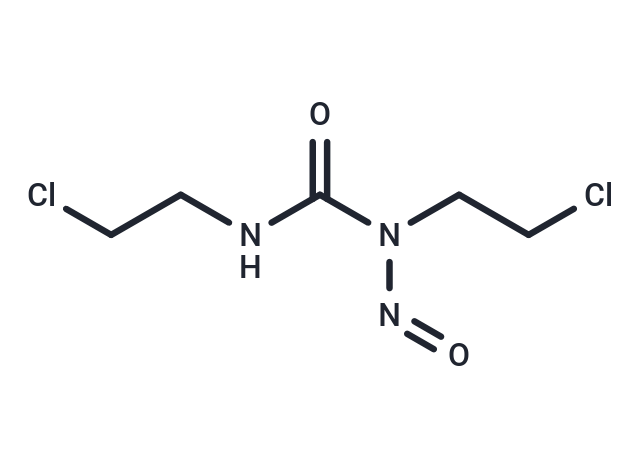Shopping Cart
- Remove All
 Your shopping cart is currently empty
Your shopping cart is currently empty

Carmustine (bis-chloroethylnitrosourea) is a cell-cycle phase nonspecific alkylating antineoplastic agent.

| Pack Size | Price | Availability | Quantity |
|---|---|---|---|
| 10 mg | $40 | In Stock | |
| 25 mg | $52 | In Stock | |
| 50 mg | $64 | In Stock | |
| 100 mg | $108 | In Stock | |
| 200 mg | $168 | In Stock | |
| 500 mg | $297 | In Stock |
| Description | Carmustine (bis-chloroethylnitrosourea) is a cell-cycle phase nonspecific alkylating antineoplastic agent. |
| Targets&IC50 | DNA Alkylator: |
| In vitro | Carmustine is an antitumor chemotherapeutic agent. Carmustine (8, 80, and 800 μM) decreases N-acetyltransferase (NAT) activities for 2-aminofluorene (AF) and p-aminobenzoic acid (PABA) in rat glial tumor cytosol and intact cells. The carmustine decreases the formation of DNA-AF adduct when the DNA-AF adduct increases in rat glial tumor cell. |
| In vivo | Carmustine (BCNU; 25 mg/kg, i.p.) increases the ratio of liver weight to body weight and levels of plasma conjugated bilirubin, while reducing biliary flow and oxidized glutathione levels (GSSG), along with a decrease in the ratio of reduced glutathione (GSH) to GSSG, compared to control rats. |
| Kinase Assay | The determination of Acetyl-CoAdependent N-acetylation of 2-aminofluorene (AF) and p-aminobenzoic acid (PABA) are performed. Incubation mixtures in the assay system consists of a total volume of 90 μL: glial tumor cells cytosols, diluted as required, in 50 μL of lysis buffer (20 mM Tris/HCl, pH 7.5, 1 mM DTT and 1 mM EDTA), 20 μL of an Acetyl-CoA recycling mixture of 50 mM Tris-HCl (pH7.5), 0.2 mM EDTA, 2 mM DTT, 15 mM acetylcamitine, 2U/mL carnitine acetyltransferase, and AF or PABA at specific concentrations. The reactions are started by addition of 20 μL of Acetyl-CoA. The control reactions have 20 μL distilled water in place of Acetyl-CoA. For the single point activity measurements, the final concentration of AF or PABA is 0.1 mM and AcCoA is 0.5 mM. The reaction mixtures with or without specific concentrations of Carmustine and lomustine are incubated at 37°C for 10 min and stopped with 50 μL of 20% trichloroacetic acid for the PABA reactions, and 100 μL of acetonitrile for the AF reactions. All of the reactions (experiments and controls) are run in triplicate |
| Animal Research | Carmustine is formulated in corn oil.RatsIndividual rats are weighted prior to enter the study; their weights are recorded, and they are randomLy assigned to four groups. Group I (saline group); This group consists of 12 rats. These rats are injected with 2 mL/kg of saline intraperitoneally (IP) 48 h before the study, being included by the study 48 h later. Group II (corn oil group) consists of 15 rats. These rats are injected with 2 mL/kg of corn oil (vehicle) IP 48 h before the study. Group III (Carmustine group) consists of 16 rats. These rats are injected with 1 mL per day of saline IP, administered at the same hour of the day as a single-dose for 3 days. Twelve hours after the first dose of saline, corn oil 2 mL/kg + Carmustine 25 mg/kg IP are injected, and the rats are included in the study 48 h after the administration of corn oil + Carmustine. Group IV (trimetazidine group) consists of 12 rats. These rats are injected with 2.5 mg/kg per day of trimetazidine (TMZ) IP, administered at the same hour of the day as a single-dose for 3 days. 12 h after the first dose of TMZ, corn oil 2 mL/kg + Carmustine 25 mg/kg IP are injected, and the rats are included in the study 48 h after the administration of corn oil + Carmustine |
| Alias | Nitrumon, Gliadel, Carmubris, bis-chloroethylnitrosourea, BiCNU, BCNU |
| Molecular Weight | 214.05 |
| Formula | C5H9Cl2N3O2 |
| Cas No. | 154-93-8 |
| Smiles | N(C(NCCCl)=O)(CCCl)N=O |
| Relative Density. | 1.46 g/ml |
| Storage | keep away from direct sunlight | Powder: -20°C for 3 years | In solvent: -80°C for 1 year | Shipping with blue ice. | |||||||||||||||||||||||||||||||||||
| Solubility Information | DMSO: 55 mg/mL (256.95 mM), Sonication is recommended. | |||||||||||||||||||||||||||||||||||
Solution Preparation Table | ||||||||||||||||||||||||||||||||||||
DMSO
| ||||||||||||||||||||||||||||||||||||

Copyright © 2015-2025 TargetMol Chemicals Inc. All Rights Reserved.